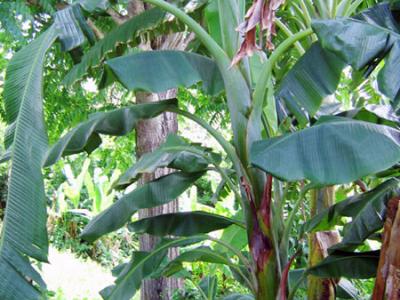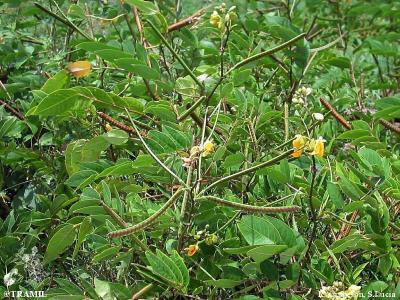(In territories with significant traditional TRAMIL use)
Barbados:
- banana
Haiti:
- bannan matenten
Dominican Republic:
- rulo
fruit peel sap (latex) ("mancha"), applied locally2-3
According to published and other information:
There is no available information in scientific literature to validate the effects attributed to the fruit pulp, broth with salt, or cooked fruit pulp, taken orally for asthenia and weakness.
Use for diarrhea is classified as REC, based on the significant traditional use documented in the TRAMIL surveys and on available published scientific information.
In case of diarrhea, the use of this resource can be considered complementary to oral re-hydration therapy.
Should there be a notable worsening of the patient’s condition, or should diarrhea last more than 3 days in adults or 2 days in children older than 3, seek medical attention.
Use for injury, sore, inflammation and rheumatism is classified as REC, based on the significant traditional use (OMS/WHO)4 documented in the TRAMIL surveys.
For topical application, strict hygiene measures should be observed in order to avoid contamination or additional infection.
Should there be a notable worsening of the patient’s condition, seek medical attention.
Not for use by children under 6 months of age.
The fruit of Musa xparadisiaca is widely used for human consumption and the leaf of the plant is used for producing foodstuffs.
TRAMIL Research16
For inflammation:
Prepare a decoction with 100-200 grams of ground leaf in 1 liter (4 cups) of water. Boil for at least 10 minutes in a covered pot. Filter, leave to cool down and soak affected area.
For injury and sore:
Wash injury with boiled water and soap. Apply the grated mesoderm (pulp) of the fruit or the sap of the fruit peel to affected area16. Cover injury with dressing or clean cloth, and replace 2 times a day.
For asthenia, weakness, diarrhea and rheumatism:
There is no available information establishing a means of preparation and dosage other than that referred to by traditional use.
Any medicinal preparation must be preserved cold and used within the 24 hours.
1 SIMMONDS NW, 1962
The evolution of the bananas. London, England: Longmans, Green & Co. Ltd. p170.
2 WENIGER B, ROUZIER M, 1986
Enquête TRAMIL. Service Oecuménique d'Entraide SOE, Port au Prince, Haïti.
3 FAUJOUR A, MURREY D, CHELTENHAM-CORBIN B, CARRINGTON S, 2003
TRAMIL survey. enda-caribbean, IICA & UAG, Saint Thomas, Barbados.
4 GERMOSEN-ROBINEAU L, GERONIMO M, AMPARO C, 1984
Encuesta TRAMIL. enda-caribe, Santo Domingo, Rep. Dominicana.
5 PALMER J, WYMAN H, 1965
Organic acids in banana leaves. Phytochemistry 4(2):305-309.
6 WONG W, 1976
Some folk medicinal plants from Trinidad. Econ Bot 30:103-142.
7 DUTTA PK, DAS AK, BANERJI N, 1983
A tetracyclic triterpenoid from Musa paradisiaca. Phytochemistry22(11):2563-2564.
8 WILLAMAN JJ, HUI-LIN L, 1970
Alkaloid-bearing plants and their contained alkaloids, 1957-1968. Lloydia33(3A)Supp.
9 FRIESE FW, 1934
Plantas medicinais brasileiras. Sao Paulo, Brasil: Inst Agro do Estado Sao Paulo. p252-494.
10 DUKE JA, ATCHLEY AA, 1986
Handbook of proximate analysis tables of higher plants.Boca Raton, USA: CRC Press.
11 MORON FJ, GARCIA AI, VICTORIA MC, MOREJON Z, LOPEZ M, BACALLAO Y, FUENTES V, 2008
Acción analgésica oral de la decocción de hojas frescas de Musa x paradisiaca L. (plátano) en ratones. Trabajo TRAMIL. Laboratorio Central de Farmacología. Universidad de Ciencias Médicas de La Habana, Cuba.
12 FRIAS AI, GARCIA N, MOREJON Z, MORON F, VICTORIA MC, 2009
Efecto antiinflamatorio tópico de la decocción de hojas frescas de Musa x paradisiaca L. (plátano) en el edema de la oreja inducido por aceite de Croton en ratones. Trabajo TRAMIL. Laboratorio Central de Farmacología. Universidad de Ciencias Médicas de La Habana, Cuba.
13 MORON FJ, MOREJON Z, VICTORIA MC, BACALLAO Y, FUENTES V, 2009
Acción sobre el tránsito intestinal del zumo fresco del fruto maduro de Musa x paradisiaca L. (plátano) en ratones. Trabajo TRAMIL. Laboratorio Central de Farmacología. Universidad de Ciencias Médicas de La Habana, Cuba.
14 RICHTER E, VORE L, 1989
Antimicrobial activity of banana puree. Food Microbiol 6(3):179-187.
15 ALONSO J, 1998
Tratado de fitomedicina: bases clínicas y farmacológicas. Buenos Aires, Argentina: ISIS ediciones SRL. p125-126.
16 NEGWER M, 1987
Organic chemical drugs and their synonyms (an international survey). 6th ed. Berlin, Germany: Akademie Verlag.
17 CARBALLO A, 1995
Plantas medicinales del Escambray cubano. Informe TRAMIL. Laboratorio provincial de producción de medicamentos, Sancti Spiritus, Cuba.
18 PAZOS L, COTO T, CAIZA F, 2009
Irritación dérmica, piel lesionada en conejos, de la savia del fruto verde de Musa paradisiaca. Informe TRAMIL. Laboratorio de Ensayos Biológicos, LEBi, Universidad de Costa Rica, San Pedro, Costa Rica.
19 PAZOS L, COTO T, CAIZA F, 2009
Irritación dérmica, piel lesionada en conejos, del mesodermo del fruto maduro de Musa paradisiaca. Informe TRAMIL. Laboratorio de Ensayos Biológicos, LEBi, Universidad de Costa Rica, San Pedro, Costa Rica.
20 PAZOS L, COTO T, CAIZA F, 2009
Irritación dérmica, piel sana en conejos, porción de hoja calentada de Musa paradisiaca. Informe TRAMIL. Laboratorio de Ensayos Biológicos, LEBi, Universidad de Costa Rica, San Pedro, Costa Rica.
21 CARBALLO A, 1995
Cálculo de concentración y dosis de las drogas vegetales TRAMIL: Mensuraciones farmacognósticas y aproximaciones técnico-clínicas. Laboratorio provincial de producción de medicamentos, Sancti Spiritus, Cuba.



